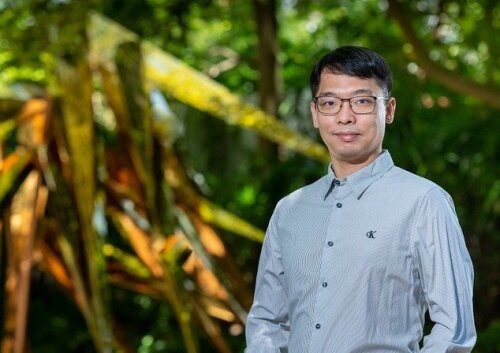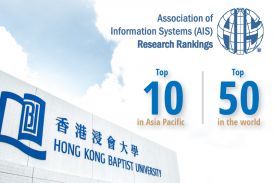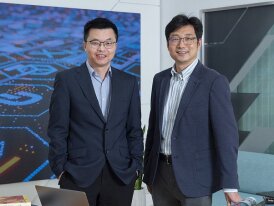
Cracking our genetic code

Computers have completely revolutionised the way we map and understand complicated biological processes, and at HKBU, Dr Eric Zhang is developing computational tools to unlock the multitude of genetic secrets stored inside our bodies and find targets for prevalent diseases.
"Humans are very complex," says Dr Zhang, an Assistant Professor of the Department of Computer Science. "Technology has improved, and modern sequencing techniques now produce a lot of genomics data every day, so we need computer scientists to provide other researchers with efficient algorithms or tools to help them better analyse this data."
While the field of bioinformatics is relatively young, the use of computers – and more recently artificial intelligence (AI) and deep learning – has led to huge changes in the biomedical sciences, and this is something that Dr Zhang is keen to take advantage of.
"It's a good opportunity for computer scientists, as we can help biologists or doctors diagnose diseases and use the power of the algorithm or modelling to help them better understand the biological phenomena and generate more useful knowledge. We also have a big problem with ageing populations, so we can use these computational tools to solve problems and improve people's quality of life."
But to identify suitable drug targets for these common age-associated diseases, first we need to make sense of the masses of muddled data that is produced by modern sequencing techniques. "I think the largest challenge is still the data itself. Most of the biological data is pretty messy and complex, so we need to analyse the data and show the findings," says Dr Zhang.
Making sense of the data
Our knowledge of what's occurring inside our cells and bodies has been transformed in recent times, and we now have a much clearer idea of the structure and function of DNA, the two stranded helical molecule which contains all our genetic information.
Yet our own DNA does not tell the whole story, as our bodies also host trillions of bacteria, including the microbes in our gut. These bacterial communities, otherwise known as the microbiome, play an important role in human health, and a field called metagenomics can also help us understand the interactions between host and organism and the role of the microbiome. As a result, understanding how all these factors interact and contribute to certain diseases remains an incredibly important area of study, and we still have much to learn.
"While bioinformatics is a big field, I'm currently working on how to apply AI to genomics data, and specifically, the human microbiome," says Dr Zhang. "Based on my previous experience of working on complex diseases and human genomics data, I think this experience can be extended to the human gut microbiome, which can be related to multiple human complex diseases, even cancer."
While traditionally it has taken a long time to explore and map these areas, technological leaps in genomic sequencing, and the use of techniques such as high-throughput sequencing, have led to great advances. However, with all this data comes an additional challenge, as the data is more complex than the human genome and there is so much more of it. The mixture of different species together also means it’s more difficult for biologists to extract data, but AI modelling can help scientists produce useful information.
Dr Zhang says that some less complicated projects produce around 10 GB of short-read sequencing data to capture the microbial abundance, but much more data is needed to assemble the genome sequences for each bacterial species. "For a current project for metagenome assembly, we may need around 90 GB because we want to generate genome sequences for each species," he says.
Focusing on Chinese medicine
With his interdisciplinary background in biology, statistics and computer science, Dr Zhang possesses the wide range of knowledge and skills that many modern researchers need. Having completed his undergraduate degree in Software Engineering at Tianjin University in mainland China, he moved to Hong Kong to study for an MPhil from the Li Ka Shing Faculty of Medicine at The University of Hong Kong and a PhD degree in Computer Science from City University of Hong Kong. He then moved to the US and Stanford University, where he was a postdoctoral fellow in the Department of Computer Science and Pathology, before returning to Hong Kong.
I think Hong Kong and HKBU are good places to do interdisciplinary research, and when I decided to go back to Hong Kong from Stanford, I found that HKBU had the strongest Chinese medicine school.
Dr Eric Zhang
Department of Computer Science
"I think Hong Kong and HKBU are good places to do interdisciplinary research, and when I decided to go back to Hong Kong from Stanford, I found that HKBU had the strongest Chinese medicine school. I think the microbiome and Chinese medicine have a big future, and I want to collaborate with Chinese medicine researchers on more drug discovery projects."
Currently, Dr Zhang is collaborating with scholars from the School of Chinese Medicine (SCM), as well as other researchers in the Department of Biology, on important issues around gastrointestinal tract-related diseases and drug discovery, and these topics will also be explored in the ground-breaking new Centre for Chinese Herbal Medicine Drug Development.
"Around 10 years ago, people recognised that Chinese medicine potentially interacts with the human gut microbiome. SCM is developing Chinese medicine drugs, and I believe that the human gut microbiome could be helpful for their Chinese medicine research," says Dr Zhang.
Other researchers will also be able to use the tools developed by Dr Zhang, and he says that their feedback is vital in terms of the continued development and improvement of the algorithms. He also hopes to identify suitable targets and develop better drugs.
"The next steps for me involve continuing to develop the AI algorithms and working on drug discovery with SCM," he says. "Hopefully, we can find a drug target, and develop a small molecule or another kind of drug which can be used to treat this target. But how to identify, develop and design more efficient drugs to treat this target is my next goal."
Previous News
Next News



